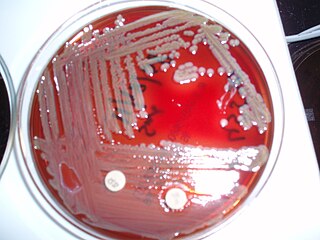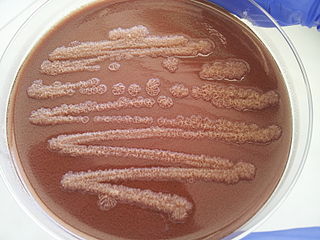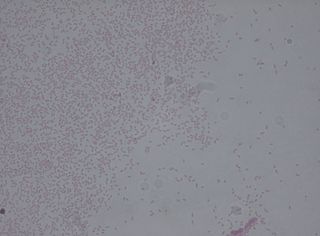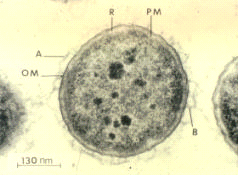
Aeromonas is a genus of Gram-negative, facultative anaerobic, rod-shaped bacteria that morphologically resemble members of the family Enterobacteriaceae. Most of the 14 described species have been associated with human diseases. The most important pathogens are A. hydrophila, A. caviae, and A. veronii biovar sobria. The organisms are ubiquitous in fresh and brackish water.
Aeromonas veronii is a Gram-negative, rod-shaped bacterium found in fresh water and in association with animals. It can be a pathogen of humans and a beneficial symbiont of leeches. In humans A. veronii can cause diseases ranging from wound infections and diarrhea to sepsis in immunocompromised patients. Humans treated with medicinal leeches after vascular surgery can be at risk for infection from A. veronii and are commonly placed on prophylactic antibiotics. Most commonly ciprofloxacin is used but there have been reports of resistant strains leading to infection. In leeches, this bacterium is thought to function in the digestion of blood, provision of nutrients, or preventing other bacteria from growing.

Aeromonas hydrophila is a heterotrophic, Gram-negative, rod-shaped bacterium mainly found in areas with a warm climate. This bacterium can be found in fresh or brackish water. It can survive in aerobic and anaerobic environments, and can digest materials such as gelatin and hemoglobin. A. hydrophila was isolated from humans and animals in the 1950s. It is the most well known of the species of Aeromonas. It is resistant to most common antibiotics and cold temperatures and is oxidase- and indole-positive.

Elizabethkingia meningoseptica is a Gram-negative, rod-shaped bacterium widely distributed in nature. It may be normally present in fish and frogs; it may be isolated from chronic infectious states, as in the sputum of cystic fibrosis patients. In 1959, American bacteriologist Elizabeth O. King was studying unclassified bacteria associated with pediatric meningitis at the Centers for Disease Control and Prevention in Atlanta, when she isolated an organism that she named Flavobacterium meningosepticum. In 1994, it was reclassified in the genus Chryseobacterium and renamed Chryseobacterium meningosepticum(chryseos = "golden" in Greek, so Chryseobacterium means a golden/yellow rod similar to Flavobacterium). In 2005, a 16S rRNA phylogenetic tree of Chryseobacteria showed that C. meningosepticum along with C. miricola were close to each other but outside the tree of the rest of the Chryseobacteria and were then placed in a new genus Elizabethkingia named after the original discoverer of F. meningosepticum.
Pseudomonas oryzihabitans, also known as Flavimonas oryzihabitans, is a nonfermenting yellow-pigmented, gram-negative, rod-shaped bacterium that can cause sepsis, peritonitis, endophthalmitis, and bacteremia. It is an opportunistic pathogen of humans and warm-blooded animals that is commonly found in several environmental sources, from soil to rice paddies. They can be distinguished from other nonfermenters by their negative oxidase reaction and aerobic character. This organism can infect individuals that have major illnesses, including those undergoing surgery or with catheters in their body. Based on the 16S RNA analysis, these bacteria have been placed in the Pseudomonas putida group.

Pseudomonas stutzeri is a Gram-negative soil bacterium that is motile, has a single polar flagellum, and is classified as bacillus, or rod-shaped. While this bacterium was first isolated from human spinal fluid, it has since been found in many different environments due to its various characteristics and metabolic capabilities. P. stutzeri is an opportunistic pathogen in clinical settings, although infections are rare. Based on 16S rRNA analysis, this bacterium has been placed in the P. stutzeri group, to which it lends its name.

Enterobacter cloacae is a clinically significant Gram-negative, facultatively-anaerobic, rod-shaped bacterium.

Pantoea agglomerans is a Gram-negative bacterium that belongs to the family Erwiniaceae.

Cronobacter sakazakii, which before 2007 was named Enterobacter sakazakii, is an opportunistic Gram-negative, rod-shaped, pathogenic bacterium that can live in very dry places. The majority of Cronobacter sakazakii cases are adults but low-birth-weight preterm neonatal and older infants are highest at risk. The disease is associated with a rare cause of invasive infection infants with historically high case fatality rates (40–80%).
Bartonella rochalimae is a recently discovered strain of Gram-negative bacteria in the genus Bartonella, isolated by researchers at the University of California, San Francisco (UCSF), Massachusetts General Hospital, and the United States Centers for Disease Control and Prevention. The bacterium is a close relative of Bartonella quintana, the microbe which caused trench fever in thousands of soldiers during World War I. Named after Brazilian scientist Henrique da Rocha Lima, B. rochalimae is also closely related to Bartonella henselae, a bacterium identified in the mid-1990s during the AIDS epidemic in San Francisco as the cause of cat scratch fever, which still infects more than 24,000 people in the United States each year.

Aeromonas salmonicida is a pathogenic bacterium that severely impacts salmonid populations and other species. It was first discovered in a Bavarian brown trout hatchery by Emmerich and Weibel in 1894. Aeromonas salmonicida's ability to infect a variety of hosts, multiply, and adapt, make it a prime virulent bacterium. A. salmonicida is an etiological agent for furunculosis, a disease that causes sepsis, haemorrhages, muscle lesions, inflammation of the lower intestine, spleen enlargement, and death in freshwater fish populations. It is found worldwide with the exception of South America. The major route of contamination is poor water quality; however, it can also be associated stress factors such as overcrowding, high temperatures, and trauma. Spawning and smolting fish are prime victims of furunculosis due to their immunocompromised state of being.

Streptococcus iniae is a species of Gram-positive, sphere-shaped bacterium belonging to the genus Streptococcus. Since its isolation from an Amazon freshwater dolphin in the 1970s, S. iniae has emerged as a leading fish pathogen in aquaculture operations worldwide, resulting in over US$100M in annual losses. Since its discovery, S. iniae infections have been reported in at least 27 species of cultured or wild fish from around the world. Freshwater and saltwater fish including tilapia, red drum, hybrid striped bass, and rainbow trout are among those susceptible to infection by S. iniae. Infections in fish manifest as meningoencephalitis, skin lesions, and septicemia.
Aeromonas schubertii is a Gram-negative, rod-shaped bacterium. Its type strain is ATCC 43700. It is differentiated from other species by not metabolising D-mannitol. It is resistant to ampicillin and carbenicillin and susceptible to most other agents. It causes infection in several species, including humans and Channa argus.
Laribacter hongkongensis is a species of bacteria. It is facultatively anaerobic, non-sporulating, gram-negative, seagull- or spiral rod-shaped. It is a potential human pathogen. Laribacter hongkongensis has been isolated from human cases of diarrhea, but its role in causing diarrhea is unproven, even though it has been hypothesized. Additional studies are needed to better define its role as a possible enteric pathogen. These should include: case control studies designed to differentiate infection from colonization-transient passage, fulfilling Koch’s postulates and Bradford-Hill’s criteria on association vs. causation, possible virulence factors, animal models, host factors, antibody respones based on serodiagnostic testing, and human volunteer studies. The lessons learned from trying to establish the etiological role of the bacteria genera Aeromonas, Plesiomonas, and Edwardsiella in human diarrhea seem especially applicable for Laribacter. All four genera are isolated from extraintestinal infections, are apparently found in the aquatic environment, and epidemiological associations include eating fish and foreign travel. Even after over 50 years’ experience with the former three genera their etiological role in an individual case of human diarrhea is difficult to determine without extensive studies. For all four of these genera the critical issue will be differentiating infection from colonization or transient passage in the intestine.
Aeromonas eucrenophila is a Gram-negative bacterium of the genus Aeromonas isolated from fresh water and infected fish. A. eucrenophila is a pathogen of fish, and it causes diarrhoea in humans.
Aeromonas fluvialis is a Gram-negative, oxidase- and catalase-positive, facultatively anaerobic, non-spore-forming bacterium of the genus Aeromonas isolated from water from the Muga River in Girona in northeastern Spain.
Aeromonas popoffii is a Gram-negative bacterium of the genus Aeromonas isolated from drinking water production plants and reservoirs in Oelegem, Belgium, and in Scotland.
Aeromonas sanarellii is a Gram-negative, oxidase- and catalase-positive, non-spore-forming bacterium of the genus Aeromonas isolated from wounds of patients in a hospital in Taiwan.
Aeromonas taiwanensis is a Gram-negative, oxidase- and catalase-positive, non-spore-forming, motile bacterium of the genus Aeromonas isolated from wounds of patients in Taiwan.
Aeromonas tecta is a Gram-negative bacterium of the genus Aeromonas isolated from stool of a child with diarrhoea, a healthy patient, and environmental sources.








